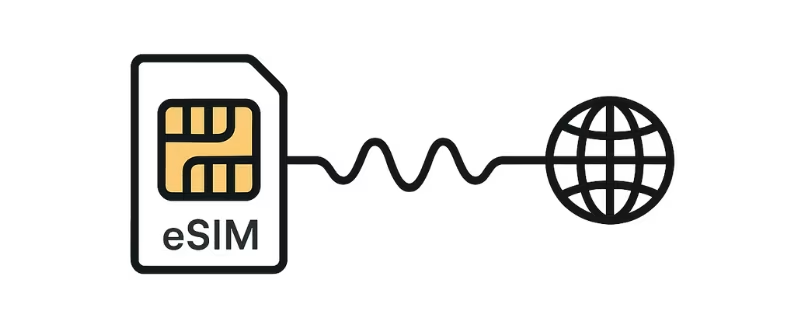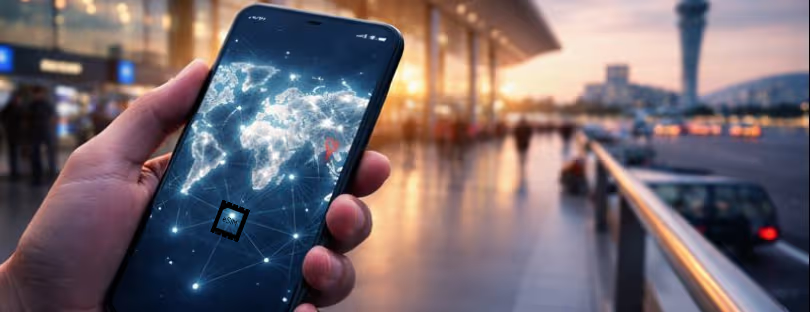
eSIM Latency: What It Is and Why It (Sometimes) Matters
Let’s face it — we all want fast. Fast internet, fast flights, fast delivery, fast check-ins, and fast answers. So when something lags — especially when you’re traveling and relying on your phone’s data — it’s instantly frustrating. That’s where eSIM latency comes into the picture.
You might be wondering, “Wait, what does eSIM have to do with latency? Isn’t it just a virtual SIM?” Great question. Let’s unpack this in simple terms.
So, what is latency anyway?
In the tech world, latency refers to the delay between when an action is initiated and when it is actually executed. Like when you tap a link, and your browser sits there… waiting… before finally loading the page. That pause? That’s latency.
It’s measured in milliseconds (ms), and in many cases, you won’t notice it unless it’s really high. However, in activities like video calling, gaming, or using navigation apps that update in real-time, even a few hundred milliseconds can feel like an eternity.
What does latency have to do with eSIMs?
At first glance, you’d think nothing. An eSIM (embedded SIM) is just a software-based SIM that connects you to a mobile network. No physical card, no swapping trays. Just scan a QR code or install a profile, and boom — you’re online.
But here’s the twist: not all eSIM connections are created equal.
eSIM providers — especially global travel eSIMs — often rely on MVNOs (Mobile Virtual Network Operators) or roaming agreements to provide coverage across multiple countries. That’s where latency can sneak in.
The hidden travel route of your data
When you’re using a local SIM card in, let’s say, France, your data goes through a nearby server, directly routed through the French mobile operator.
But with an eSIM — especially one issued by a provider based halfway across the world — your data might take a longer route. For instance:
You’re in Thailand using an eSIM from a US-based provider. That eSIM may be tunneling your traffic through a server in the U.S. before it reaches the internet. Even if your phone says you’re connected to AIS or TrueMove, the underlying route of your data might be much longer.
More distance = more latency.
Real talk: Is eSIM latency actually a problem?
Usually? Not really.
For most people doing regular stuff like browsing, messaging, uploading photos to Instagram, or checking Google Maps, you probably won’t notice a thing.
Where it can become noticeable is:
- Video calls: That slight voice lag or awkward pause when you’re on Zoom from your hotel in Bali? Latency might be to blame.
- Online gaming: If you’re into fast-paced mobile gaming while abroad (hello, Call of Duty Mobile), latency can make gameplay feel sluggish.
- Streaming HD or 4K video: Higher latency can result in buffering or lower stream quality, especially during peak hours.
What’s causing the latency on eSIMs?
A few key culprits:
- Home routing: Some eSIM providers route traffic back to their home country or central servers before connecting to the internet. That’s a major source of added latency.
- Network priority: MVNOs often don’t get the same network priority as local users, which can lead to higher ping times during peak usage hours.
- Server location: If the DNS (domain name system) or content server you’re trying to access is far from where your eSIM routes, it can add to the delay.
- VPN-like tunneling: Some global eSIMs work almost like a VPN, encrypting and rerouting your traffic through central hubs. Safe, yes. Fast? Not always.
Is this unique to eSIMs?
Not entirely. You can also experience latency on physical SIM cards, especially when roaming internationally. The difference is that eSIMs designed for global travel often use more indirect routing, depending on the provider’s infrastructure.
Some eSIMs actually perform better than physical SIMs when roaming, especially if the provider has direct agreements with local carriers and edge servers in multiple countries. It’s not about the “e” — it’s about how smart and local the connection is.
How to reduce eSIM latency while traveling
Here’s the good news — not all hope is lost. You can take a few steps to minimize latency:
1. Choose a local eSIM or regional plan
Whenever possible, choose eSIM providers that partner directly with local carriers or offer local breakouts (routing your data locally rather than through home servers).
Providers like Airalo, Nomad, or Airhub sometimes offer truly local profiles. Always check the fine print or FAQs.
2. Avoid the cheapest option
Cheap eSIMs are tempting, but they might be using global routing paths with higher latency. If your work or streaming quality matters, pay for quality.
3. Disable VPN if not needed
Using a VPN on top of an eSIM that’s already routing through another country? Double trouble. Unless you’re privacy-focused, turn off the VPN when you want speed.
4. Reset your APN settings
If your speeds or latency are off, resetting your APN (access point name) can sometimes help. This lets your phone refresh its connection to the network.
5. Use Wi-Fi where available
Yes, it sounds obvious, but a solid hotel or café Wi-Fi is still your best friend when latency is driving you crazy.
So… should you avoid eSIMs?
Absolutely not.
eSIMs are amazing. They’ve revolutionized how we connect while traveling — no more hunting for kiosks, swapping SIM trays, or worrying about losing your original SIM. For most travelers, the convenience far outweighs the potential downsides.
Just like with anything else tech-related, knowing the limitations helps you make smarter choices. And now that you know what eSIM latency is, you’re ahead of 99% of travelers.
The bottom line
eSIM latency exists, but it’s not a dealbreaker. It’s just one of those behind-the-scenes quirks that can affect performance depending on where you are, which provider you’re using, and what you’re trying to do.
If you’re video-calling your team from a mountain village in Peru or trying to stream Netflix on a beach in Vietnam, your eSIM’s routing path might add a bit of delay. But for checking your email, navigating cities, uploading your travel reels, or messaging your hostel host? You’ll be just fine.
Final Tip: If latency really bothers you, do a quick ping test when you land. There are free apps that show your latency to a server. That gives you a real-world look at your eSIM performance — and helps you decide if it’s time to switch to Wi-Fi (or try a different provider next time).
Got an eSIM story with weird lag or lightning-fast speeds? Let’s talk in the comments 👇










